
A solar deity or sun deity is a deity who represents the Sun, or an aspect of it. Such deities are usually associated with power and strength. Solar deities and Sun worship can be found throughout most of recorded history in various forms. The Sun is sometimes referred to by its Latin name Sol or by its Greek name Helios. The English word sun derives from Proto-Germanic *sunnǭ.

The cosmos is another name for the universe. Using the word cosmos implies viewing the universe as a complex and orderly system or entity. The cosmos, and understandings of the reasons for its existence and significance, are studied in cosmology – a broad discipline covering scientific, religious or philosophical aspects of the cosmos and its nature. Religious and philosophical approaches may include the cosmos among spiritual entities or other matters deemed to exist outside the physical universe.

Thoth is an ancient Egyptian deity. In art, he was often depicted as a man with the head of an ibis or a baboon, animals sacred to him. His feminine counterpart was Seshat, and his wife was Ma'at. He was the god of the Moon, wisdom, knowledge, writing, hieroglyphs, science, magic, art and judgment.
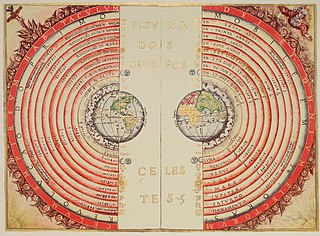
In astronomy, the geocentric model is a superseded description of the Universe with Earth at the center. Under most geocentric models, the Sun, Moon, stars, and planets all orbit Earth. The geocentric model was the predominant description of the cosmos in many European ancient civilizations, such as those of Aristotle in Classical Greece and Ptolemy in Roman Egypt, as well as during the Islamic Golden Age.

Nut, also known by various other transcriptions, is the goddess of the sky, stars, cosmos, mothers, astronomy, and the universe in the ancient Egyptian religion. She was seen as a star-covered nude woman arching over the Earth, or as a cow. She was depicted wearing the water-pot sign (nw) that identifies her.
The Ennead or Great Ennead was a group of nine deities in Egyptian mythology worshipped at Heliopolis: the sun god Atum; his children Shu and Tefnut; their children Geb and Nut; and their children Osiris, Isis, Set, and Nephthys. The Ennead sometimes includes Horus the Elder, an ancient form of the falcon god, not the son of Osiris and Isis.

Nehebkau was the primordial snake god in ancient Egyptian mythology. Although originally considered an evil spirit, he later functions as a funerary god associated with the afterlife. As one of the forty-two assessors of Ma’at, Nehebkau was believed to judge the deceased after death and provide their souls with ka – the part of the soul that distinguished the living from the dead.
The heliacal rising or star rise of a star occurs annually, or the similar phenomenon of a planet, when it first becomes visible above the eastern horizon at dawn just before sunrise after a complete orbit of the Earth around the Sun. Historically, the most important such rising is that of Sirius, which was an important feature of the Egyptian calendar and astronomical development. The rising of the Pleiades heralded the start of the Ancient Greek sailing season, using celestial navigation, as well as the farming season. Helical rising is one of several types of risings and settings, mostly they are grouped into morning and evening risings and settings of objects in the sky. Culmination in the evening and then morning is set apart by half a year, while on the other hand risings and settings in the evenings and the mornings are only at the equator set apart by half a year.

The Goddess movement is a revivalistic Neopagan religious movement which includes spiritual beliefs and practices that emerged predominantly in the Western world during the 1970s. The movement grew as a reaction both against Abrahamic religions, which exclusively have gods with whom are referred by masculine grammatical articles and pronouns, and secularism. It revolves around Goddess worship and the veneration for the divine feminine, and may include a focus on women or on one or more understandings of gender or femininity.
Nature worship also called naturism or physiolatry is any of a variety of religious, spiritual and devotional practices that focus on the worship of the nature spirits considered to be behind the natural phenomena visible throughout nature. A nature deity can be in charge of nature, a place, a biotope, the biosphere, the cosmos, or the universe. Nature worship is often considered the primitive source of modern religious beliefs and can be found in pantheism, panentheism, deism, polytheism, animism, Taoism, totemism, Hinduism, shamanism, some theism and paganism including Wicca. Common to most forms of nature worship is a spiritual focus on the individual's connection and influence on some aspects of the natural world and reverence towards it. Due to their admiration of nature, the works of Edmund Spenser, Anthony Ashley-Cooper and Carl Linnaeus were viewed as nature worship.
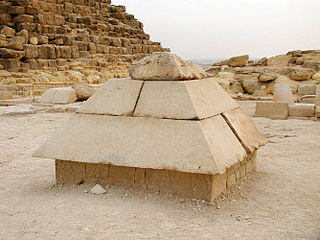
In the creation myth of the Heliopolitan form of ancient Egyptian religion, Benben was the mound that arose from the primordial waters Nu upon which the creator deity Atum settled. The Benben stone is the top stone of the pyramid. It is also related to the obelisk.
The religions of the ancient Near East were mostly polytheistic, with some examples of monolatry. Some scholars believe that the similarities between these religions indicate that the religions are related, a belief known as patternism.

In biblical cosmology, the firmament is the vast solid dome created by God during the Genesis creation narrative to divide the primal sea into upper and lower portions so that the dry land could appear. The concept was adopted into the subsequent Classical/Medieval model of heavenly spheres, but was dropped with advances in astronomy in the 16th and 17th centuries. Today it is known as a synonym for sky or heaven.
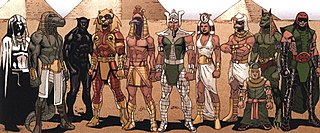
Heliopolitans are a fictional group of gods, based on Ancient Egyptian deities, appearing in American comic books published by Marvel Comics.
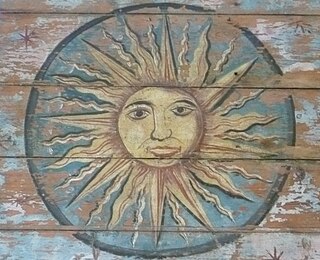
The Sun, as the source of energy and light for life on Earth, has been a central object in culture and religion since prehistory. Ritual solar worship has given rise to solar deities in theistic traditions throughout the world, and solar symbolism is ubiquitous. Apart from its immediate connection to light and warmth, the Sun is also important in timekeeping as the main indicator of the day and the year.

Egyptian astronomy began in prehistoric times, in the Predynastic Period. In the 5th millennium BCE, the stone circles at Nabta Playa may have made use of astronomical alignments. By the time the historical Dynastic Period began in the 3rd millennium BCE, the 365 day period of the Egyptian calendar was already in use, and the observation of stars was important in determining the annual flooding of the Nile.
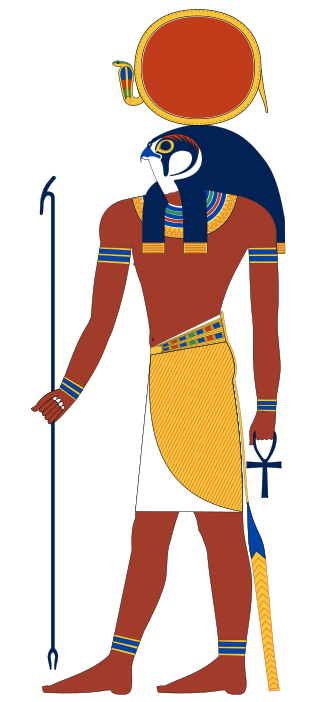
Ra or Re was the ancient Egyptian deity of the Sun. By the Fifth Dynasty, in the 25th and 24th centuries BC, he had become one of the most important gods in ancient Egyptian religion, identified primarily with the noon-day sun. Ra ruled in all parts of the created world: the sky, the Earth, and the underworld. He was believed to have ruled as the first pharaoh of Ancient Egypt. He was the god of the sun, order, kings and the sky.

Ancient Egyptian creation myths are the ancient Egyptian accounts of the creation of the world. The Pyramid Texts, tomb wall decorations, and writings, dating back to the Old Kingdom have provided the majority of information regarding ancient Egyptian creation myths. These myths also form the earliest religious compilations in the world. The ancient Egyptians had many creator gods and associated legends. Thus, the world or more specifically Egypt was created in diverse ways according to different parts of ancient Egypt. Some versions of the myth indicate spitting, others masturbation, as the act of creation. The earliest god, Ra and/or Atum, emerged from a chaotic state of the world and gave rise to Shu (air) and Tefnut (moisture), from whose union came Geb (earth) and Nut (sky), who in turn created Osiris, Isis, Set, and Nephthys. An extension to this basic framework was the Osiris myth involving Osiris, his consort Isis, and their son Horus. The murder of Osiris by Set, and the resulting struggle for power, won by Horus, provided a powerful narrative linking the ancient Egyptian ideology of kingship with the creation of the cosmos.
The worship of heavenly bodies is the veneration of stars, the planets, or other astronomical objects as deities, or the association of deities with heavenly bodies. In anthropological literature these systems of practice may be referred to as astral cults.
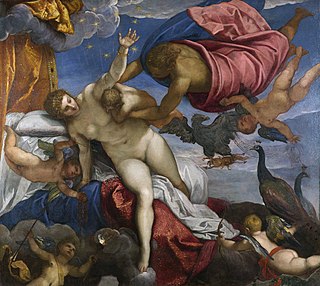
Astronomy has been a favorite and significant component of mythology and religion throughout history. Astronomy and cosmology are parts of the myths of many cultures and religion around the world. Astronomy and religion have long been closely intertwined, particularly during the early history of astronomy. Archaeological evidence of many ancient cultures demonstrates that celestial bodies were the subject of worship during the Stone and Bronze Ages. Amulets and stone walls in northern Europe depict arrangements of stars in constellations that match their historical positions, particularly circumpolar constellations. These date back as much as 30,000–40,000 years.















